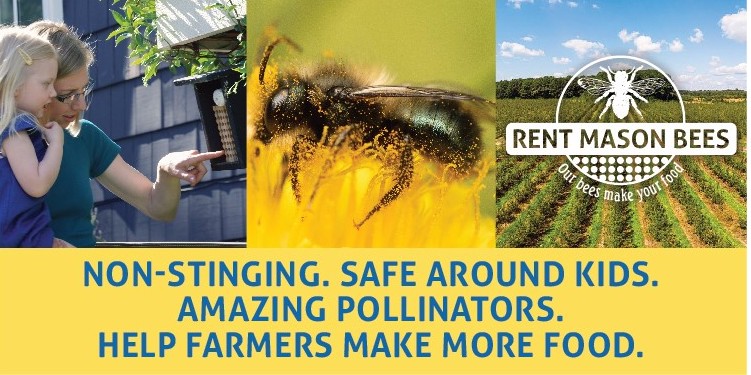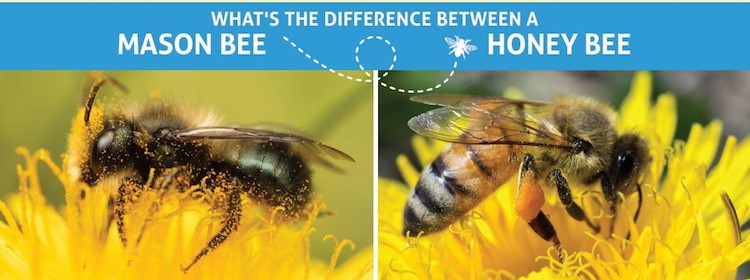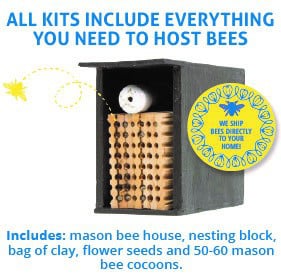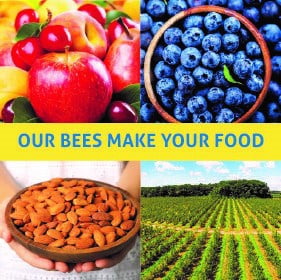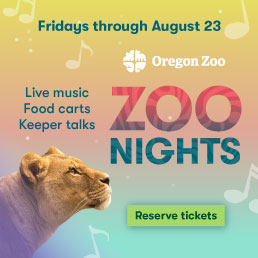From our friends at Rent Mason Bees
You may have seen a mason bee and thought it was a fly. Or heard the word mason bee and thought that they sting. Let’s learn a little more about these amazing pollinators who are helping our ecosystem, working to help honey bees and helping farmers produce more food all over the world. Click here for downloadable worksheets to help kids explore their yards.
WHAT IS A MASON BEE? Mason bees are also called a blue orchard mason bee because of their blue iridescent sheen. They are native to North America and are solitary bees, which means they don’t live in a hive, don’t have a queen bee, and all the females are able to lay eggs.
WHY ARE THEY IMPORTANT TO THE ECOSYSTEM? Mason bees are not picky pollinators, they will collect pollen and nectar from just about any plant that’s blooming in the early spring. That means not only do mason bees help us grow more food, but they pollinate our native plants too. That makes it so the plants around us are healthier, can grow larger, and can better filter our air and water, boosting the overall health of our ecosystems.
HOW DO THEY HELP FARMERS MAKE MORE FOOD? Farmers use 1,000 mason bees per acre to pollinate their crops. We need to continue to grow our mason bee population so that they can work with more farmers. By providing another bee to help pollinate our orchards, honey bees are less stressed and farmers can boost their yields.
WHAT IS THE DIFFERENCE BETWEEN A MASON BEE AND A HONEY BEE?
1) BELLY FLOPPERS – Mason bees belly flop onto the flower, which gets pollen all over their body. Whereas, a honey bee collects pollen on their back legs. This enables mason bees to pollinate 95% of the flowers they land on vs. 5% for the honey bees.
2) HOLES VS. HIVES – Honey bees work in a hive that produces honey and the queen lays eggs. Mason bees lay eggs in small tunnels or holes and don’t produce any honey.
3) WHO’S THE QUEEN – Honey bees have one queen that lays all the eggs. Mason bees are solitary bees, all females lay eggs and they work alone.
4) BABY BEES – Mason bees lay eggs that then turn into cocoons and hatch the next Spring. Honey bees lay eggs that develop into bees inside the hive.
HOW MASON BEES HELP HONEY BEES – Honey bees are overworked in the pursuit of keeping up with our high demands for food. By using more mason bees on our farms, we can lessen the stress on the honey bee populations and utilize the amazing hardiness of the mason bee to keep our grocery stores stocked with fruit.
HOW CAN YOU GET INVOLVED? Anyone can host mason bees. You don’t need a garden, just a sunny spot to hang your bee house. Pacific Northwest-based Rent Mason Bees makes it easy. They are the only company in the country who has a mason bee program where you “host” mason bees and not have to worry about cleaning or harvesting your cocoons at the end of the season. You can order your kit online and have it mailed right to your home. After your kit arrives:
- Hang your mason bee house in a sunny morning location.
- Place nesting block into the house.
- Remove tape from tube that holds 50-60 cocoons and set on top of the nesting block.
That’s it! When the weather warms up to about 50 degrees your bees will start to emerge from the tube. They will mark it with a scent so they know where to come back. Then, they will get to work pollinating trees and flowers and will lay 5-7 eggs in each hole.
In September, you’ll get a reminder to mail your nesting block full of “baby bees” back to Rent Mason Bees using your box and pre-paid shipping label. They will clean the cocoons and safely store them in hibernation over the winter. Then, the next Spring, healthy mason bee cocoons are sent to farmers all over the West Coast to pollinate crops such as apple, blueberry, pear, cherry and almond.
HOW YOU’RE MAKING A DIFFERENCE – When you host, you help pollinate gardens, put healthy bees back into the ecosystem and help farmers produce more food.
- August 2024 Digital Issue - July 26, 2024
- Our Favorite Free and Splurgy Summer Date Night Ideas - July 20, 2024
- Where to See Farm Animals around Portland - July 17, 2024


